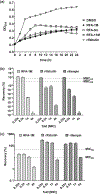Spiropiperidyl rifabutins: expanded in vitro testing against ESKAPE pathogens and select bacterial biofilms
- PMID: 32651464
- PMCID: PMC7928017
- DOI: 10.1038/s41429-020-0346-x
Spiropiperidyl rifabutins: expanded in vitro testing against ESKAPE pathogens and select bacterial biofilms
Abstract
The expanded microbiological evaluation of a series of rifastures, novel spiropiperidyl rifamycin derivatives, against clinically relevant ESKAPE bacteria has identified several analogs with promising in vitro bioactivities against antibiotic-resistant strains of Enterococcus faecium and Staphylococcus aureus. Thirteen of the rifastures displayed minimum inhibitory concentrations (MICs) below 1 µg/ml against the methicillin- and vancomycin-resistant forms of S. aureus and E. faecium (MRSA, VRSA, VRE). Aryl-substituted rifastures 1, 11, and 12 offered the greatest bioactivity, with MICs reaching ≤0.063 µg ml-1 for these human pathogens. Further analysis indicates that diphenyl rifasture 1 had greater antibiofilm activity against S. aureus and lower cytotoxicity in mammalian HEK cells than rifabutin.
Conflict of interest statement
Figures




References
-
- Sensi P, Margalith P, Timbal M. Rifomycin, a new antibiotic; preliminary report. Farmaco Ed Sci. 1959;14:146. - PubMed
-
- Riva S, Silvestri LG. Rifamycins: a general view. Annu Rev Microbiol. 1972;26:199. - PubMed
-
- Lounis N, Rosceigno G. In vitro and in vivo activities of new rifamycin derivatives against mycobacterial infections. Curr Pharm Des. 2004;10:3229. - PubMed
-
- Floss HG, Yu TW. Rifamycin-mode of action, resistance, and biosynthesis. Chem Rev. 2005;105:621. - PubMed
-
- Prelog V, Oppolzer W. Ansamycins, a novel class of microbial metabolites. Helv Chim Acta. 1973;56:2279. - PubMed
Publication types
MeSH terms
Substances
Grants and funding
LinkOut - more resources
Full Text Sources
Medical
Molecular Biology Databases
Miscellaneous

